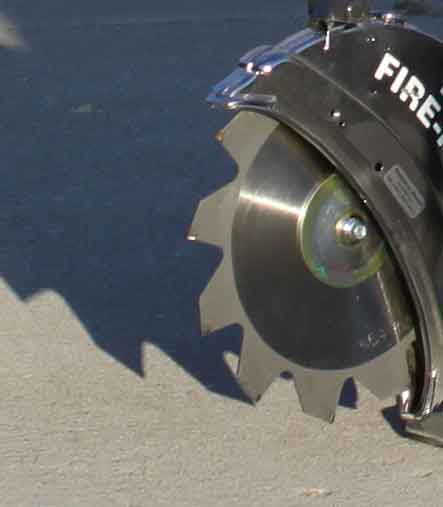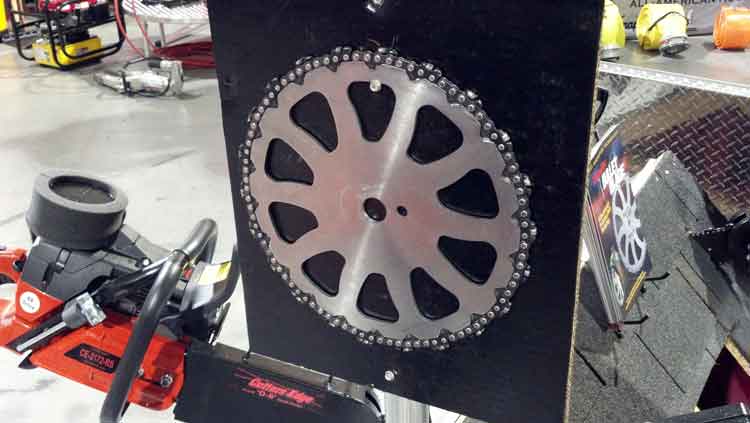
Photos and articles by Mark van der Feyst
A few of the functions of truck company operations require ventilation and forcing openings within a structure. Firefighters sometimes employ the rotary saw for these tasks. Some fire departments will have rotary saws on their apparatus to complement equipment needed to ventilate buildings and force open the building. The rotary saw offers many benefits, such as portability and power. Originally designed for the construction industry, the rotary saw has found its way into the fire service as a valuable tool.
The rotary saw is portable. It is meant to be carried anywhere on the fireground, including the roof of a building and up and down ladders, both ground and aerial. The weight of a rotary saw without fuel should be between 20-35 lbs. One firefighter can carry the saw either using the handles or using a strap attached to the saw, the latter of which can be made from webbing or even a used seat belt. Having a strap will free the hands of the firefighter so that he or she can carry other needed tools or have both hands available for climbing a ladder. It is portable enough that it could be used in small spaces such as a trench for extrication purposes, providing there are no explosive gases present.
RELATED: Gaining Entry on the C Side | Chain Saws: Applications for the Fire Service | Maximizing Circular Saw Effectiveness in Forcible Entry Operations
The rotary saw has power—all rotary saws are powered by an internal combustion engine. They have a two-stroke small gas engine providing the needed power. The small engines can range from 74-119 ccs in displacement, with horsepower ranging from 5-8hp. Because of this high power output, the saw will produce blade speeds from 4,700-5,400 rpms. This will allow the saw to cut through almost any type of material that the blade is designed and rated for. The blade size will also vary from 12-16 inches.

(1)
There are many different types of blades on the market that can be purchased, depending upon the need of the fire department. A multi-purpose blade with a diamond cutting edge is most common and is usually the most desirable. It offers a wide range of materials that can be cut with just one blade (photo 1). Small diamonds are embedded into the edge of the blade for an abrasive cutting surface. Over time and with constant usage, the edge of the blade can “gum” up with material that is being cut, which prevents the blade from cutting effectively. All that is required is to bury the blade while it is running into new or clean material momentarily for about 20 seconds to clean the cutting edge. Once done, the blade can then be re-applied to the previous cutting operation and you will see a noticeable change in the cutting effectiveness.
Over time, the small diamonds of the blade will disappear because of cutting operations on different materials. Those small diamonds that fall off or disappear are replaced with newer diamonds that are embedded below the surface of the previous layer.

(2)
In photo 2, you can see another version of a blade that is sometimes used on a rotary saw. This blade is known as a “warthog” blade. Notice the long teeth that are protruding from the blade’s center, which resembles a blade used for a table saw or a skill saw. This type of blade is great for cutting wood roofs and some siding products. At high revolutions, this blade can be dangerous when it comes to the safety with personnel around the cutting operation. It will rip very quickly through bunker gear and flesh. Although they are not designed for a specific name brand of rotary saw, be sure to check with the manufacturer to see if this blade will be compatible with your rotary saw.

(3)
A new blade now available on the market pictured in photo 3 is a hybrid version of a chain used for a vent saw and a rotary blade. It has so far proven itself to be a true “multi-purpose” blade. The chain that is wrapped around the outside of the round blade is the same chain used on a vent saw along a bar. By having it wrapped around a rotary blade, it can spin three times faster using a rotary saw. This increase allows the chain to be more effective in cutting through more types of materials. In a demonstration video of the new blade, it is used to cut through vehicles, concrete, one-inch schedule 40 metal pipes, shingled roofs, metal roofs, sheet metal ventilation hoods, cement blocks, glass windshields, and a host of other materials. The blade is effective and versatile under duress–even with missing teeth it still maintains cutting precision.

(4)
Another advantage of this blade is that it can be sharpened, have the cutters replaced, and be used over and over again. As opposed to a regular diamond blade tip, which only lasts as long as the diamonds are present, this has a dramatically longer lifespan. It also produces minimal sparks when cutting through metal objects. As shown in photo 4, when using a diamond tip blade, spark generation is quite apparent with a rooster tail being produced. This can be hazardous to the person using the saw as well as others standing nearby. If explosive gases are present or flammable objects are close by, this will be a source of ignition.
The rotary saw is a valuable piece of equipment on the fireground and should be used more often. If you are debating buying a rotary saw, consider that is is a more effective tool than a vent saw..
Next month we will look in more detail to the operation of the rotary saw with respect to different positions to hold the saw while cutting as well as some safety pointers to keep in mind.
 Mark van der Feyst has been in the fire service since 1999 and is a full-time firefighter in Ontario, Canada. He is an international instructor teaching in Canada, the United States, and India, and at FDIC. Van der Feyst is a local level suppression instructor for the Pennsylvania State Fire Academy. He is also the lead author of Residential Fire Rescue (Pennwell).
Mark van der Feyst has been in the fire service since 1999 and is a full-time firefighter in Ontario, Canada. He is an international instructor teaching in Canada, the United States, and India, and at FDIC. Van der Feyst is a local level suppression instructor for the Pennsylvania State Fire Academy. He is also the lead author of Residential Fire Rescue (Pennwell).
MORE MARK VAN DER FEYST
Truck Company Ops: Elevator Rescue
Firefighting Back-to-Basics: Standpipe Systems

